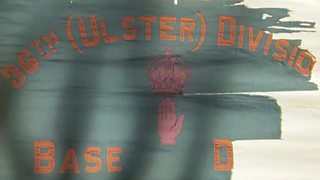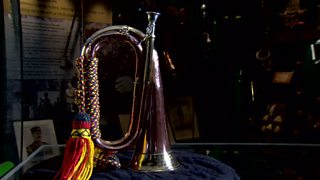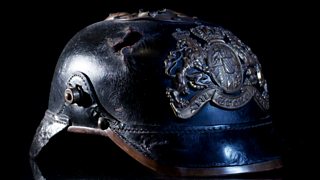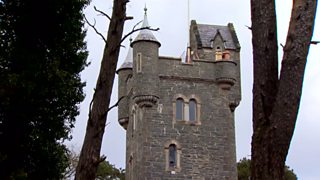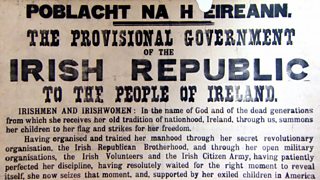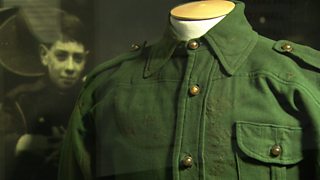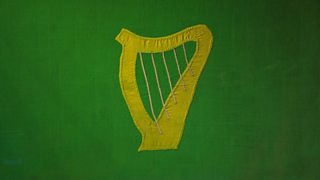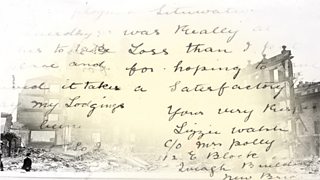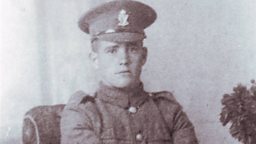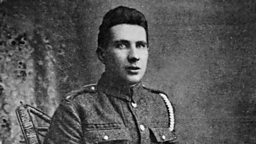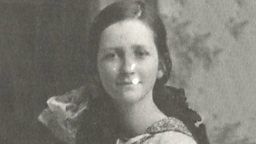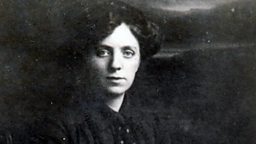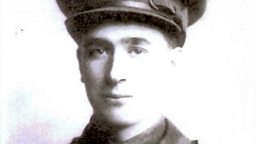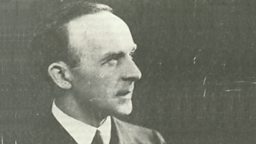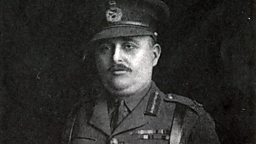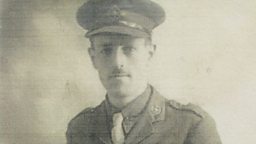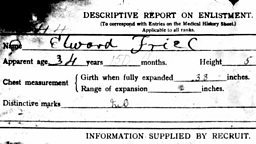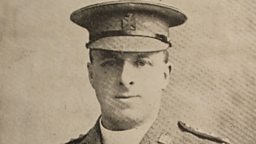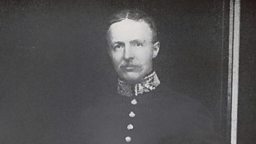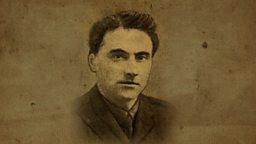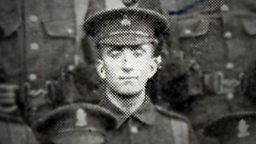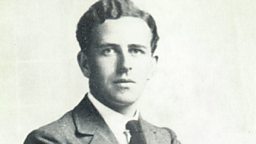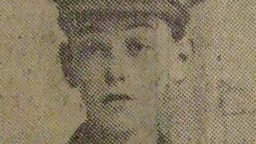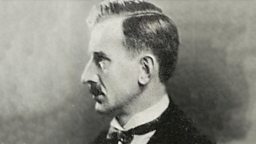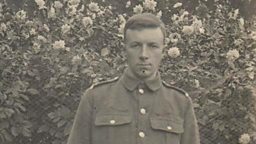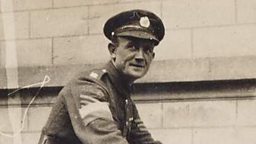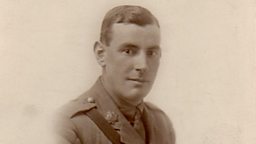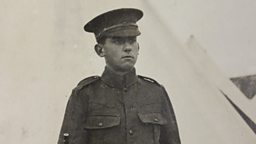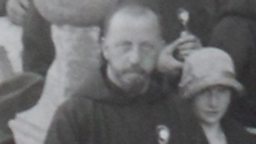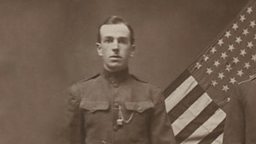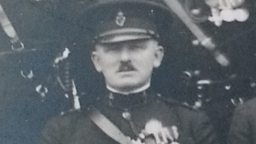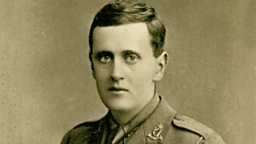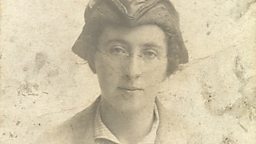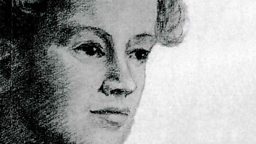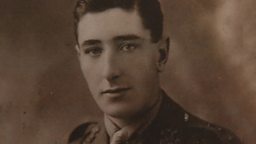James Davidson
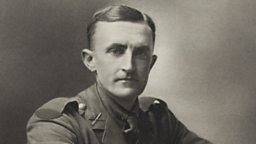
Captain, engineer, heir
James Davidson was born on 9 March 1877. He was the son of Samuel Davidson, the founder and owner of the Sirocco Engineering Works in Belfast, from which he became a very wealthy man.
It was a bit too exciting to be pleasant
James was educated at the Royal Belfast Academical Institution (RBAI or 'Inst') and Campbell College in Belfast, spending a year between his time at these two schools in Paris learning French.
He became a member of the Institute of Mechanical Engineering and worked his way up to manager in the family company. His father had insisted he begin at the bottom so he could learn everything.
He enjoyed the trappings of wealth and drove smart cars and sailed his own yacht at the Royal Ulster Yacht Club where the tea magnate, and family friend Sir Thomas Lipton, was also a member.
Davidson and Co Ltd
James eventually became a director in his father's business, Davidson and Company Ltd.
He travelled extensively in this role, accompanying his father to the 1904 St Louis World Fair and going around the world to sell Sirocco machinery from October 1910 to July 1911.
Ulster Volunteer Force
After his return home, he became a member the Ulster Volunteer Force in the midst of the ΒιΆΉΤΌΕΔ Rule crisis, becoming a member of the 1st Battalion North Down Regiment (Bangor).
Army Commission
When the United Kingdom declared war on Germany in 1914, he immediately applied for a commission and was appointed a 2nd Lieutenant with the 13th Battalion Royal Irish Rifles, 36th (Ulster) Division.
Inspected by the King
Davidson’s practical knowledge of engineering was identified and he would subsequently be attached to the Machine Gun section, rising to the rank of Brigade Captain of the Machine Gun Company of the 108th Infantry Brigade.
Before setting off for the front in October 1914, he wrote a letter to his mother telling her that "the whole Division was inspected today by the King ... and everything went off splendidly."
The Somme
Trench Life
On 6 October 1915 Davidson wrote to his mother: “We arrived at our destination yest. safe & sound after a rather long & tiresome journey … it is not very far from the firing line …”
From then on, his letters home record his experiences in the trenches, including his first impressions: “At times while we were there once could almost believe that there was no enemy within miles, although only about 200 or 300 yds separated us, as there would not be a shot fired & yet there was the certainty that if you showed your head for more than a few seconds above the parapet, a bullet would be sure to come your way.”
Though often cheery, Davidson’s letters record worsening weather across winter, with conditions becoming difficult, and moves constant. By December’s end, he wrote: “I think this must be about our 10th move since we arrived in France 3 months ago.”
Machine Gun Company
Nonetheless, Davidson was very pleased with the prospects of his Machine Gun Company, writing in January 1916: “I got instructions from the Division that the Machine Gun Company for this Brigade was to be formed almost at once … It will be a very nice little command for me once it is organised & running smoothly but like all new things in the Army practically no information is available & one is left to get over all the difficulties in the best way one can. The Company is 150 strong with 16 guns & transport & c & no less than 52 horses. I shall have 8 officers & they are all good chaps …”
Davidson was wounded slightly in February, but described this in a letter home as a lucky escape: “in case you should see my name in the wounded lists I want you to know that there is absolutely nothing to worry about. I have had a very close escape today in fact I was lucky beyond anything for the only mark I have is a tiny wee cut on the upper part of the left arm where a fragment of the shell just touched me …”
βPreparing for Something Bigβ
Getting home for leave in early April, Davidson found that “it has been a delightful little change & done me a lot of good.” But returning was difficult: “The journey seems much worse on the way back when one has nothing pleasant to look forward to …”
His letters begin to reflect a sense of impending events: “… troops are being crushed in everywhere … from now on we shall have to content ourselves with any old place for there is no doubt we are preparing for something big & it will be a case of packing as many troops as possible into the area.”
And in a letter home in early May, he reflected on events in Ireland across Easter 1916: “That has been a most disgraceful business in Dublin - perhaps the English people & the Radicals in particular will now begin to realise the truth of all we tried to make them believe in regard to the ΒιΆΉΤΌΕΔ Rule question. Do hope that a lot of the Ringleaders will be shot but doubt very much if the Govt will be firm enough to do so.”
For him, he wrote in early May, work was continuing apace: “I have simply not had a minute to myself … I feel too weary to do much letter writing … every day here is the same & the strain is considerable where there is, as at present, so much to be thought of in addition to the responsibility & physical fatigue. I suppose it’s the excitement that carries one along & we are having plenty of that these days.”
A Proposal
On a period of much-longed for leave from the front in late May 1916, Davidson made a major life decision: he proposed marriage to his sister’s best friend, Eileen Rodgers, and wrote to his mother on 5th June 1916 to say:
“This can only be a very hurried little note to tell you how happy I am about my engagement to Eileen. I expect you got rather a surprise. I told Eileen how I felt before leaving but left it at that as I thought it would be better to have nothing definite till after this awful war was over. However, this idea has not worked out, we just felt we could not go on as it were pretending so it has been all fixed up; only Mother dear, the engagement is to be kept within the family circle till I come home again. I never realised how much I cared for Eileen till I was home on leave. Don’t you think I am an extremely lucky man – I am sure we shall be very, very happy if only this war was at an end.”
Last Letters
In the preparations leading up to the Battle of the Somme, Davidson wrote that he hoped for good luck, but he also prepared for the possibility of death.
In a letter dated June 28, 1916, he pleaded with his mother, Clara Mary, not to be anxious, and asks that some of his personal belongings be left to his fiancée:
“The din is awful just now & it is impossible almost to think. The dawn of tomorrow will be the critical time for us but I hope good luck will attend us. Mother dearest I don’t want you to be too anxious about me but if I should have bad luck will you give Eileen any of my little personal things she would like to have.”
A final letter followed on 30th June:
“My dearest Mother – I thought when I wrote you last that by this time we should have got through the worst, but there were some alterations in plans & it is only now just at hands [sic]. I am well, but these past days have been very trying & to add to all the weather has been awful …
My fondest love to all,
Your loving son,
Jim.
1 July 1916
After eight o’clock on the morning of 1 July 1916, in response to a request for a Vickers Gun, the official battalion War Diary for the 13th Royal Irish Rifles reported that “Captain Davidson whose guns were in reserve was then sent out.”
At 10.20 am, the War Diary notes, Davidson reported: “Am in B line & have got up two Vickers Guns, am consolidating both. Cannot say how many infantry are in line … We cannot possible advance & reinforcements, ammn [sic] & bombs most urgently needed.”
At 12.40 pm he sent a further message: “I am holding the end of a communication trench in A Line with a few bombers & a Lewis gun. We cannot hold much longer. We are being pressed on all sides and ammunition almost finished.”
Killed in action
Death
In the afternoon of July 1st, 1916, at 3.20 pm, the official 13th Royal Irish Rifles War Diary recorded that “J Blakely came in from the sunken road & reported that Capt. Davidson had been wounded in the knee & while he & another man were carrying him out, he was shot dead between them.”
A telegram was sent to his family from the War Office, stating “that Capt J. S. Davidson Machine Gun Corps was killed in action on 1st July”.
Impact on Family
Captain Davidson’s sister, Kathleen, wrote in her diary on July 6th, 1916 of the news of her brother’s death:
“A sad sad day. Father came home by 11 o’clock train bringing news that our darling Jim had been killed on the 1st doing his duty with gallantry deserving of the VC as captain Spender wrote Father. I went at once to darling Eileen and oh! The cruel blow it was to her. Can write no more tonight. God help us all to bear this sorrow. Our darling, darling Jim.”
Next day, Kathleen described the impact of the news on them all, a day later:
“Mother very ill and not able to get up. I saw Florrie and Uncle Hugh and C came later. May and Eileen went to town in car and E was here later. Went to see her after dinner and the poor darling had a breakdown and fainted so stayed all night with her. Such a wonderful fund of sympathy being poured out to us by everyone.”
Condolence letters
In addition to formal telegrams from the War Office and the King and Queen, Davidson’s father Samuel received many letters of condolence, including one from Lieutenant WW Ashcroft written on July 3rd, 1916.
He too was a member of the Machine Gun Company of the 108th Brigade, and noted of James Davidson that “It was through him that I came to the 13th [Royal Irish Rifles]…” He went on to describe to Davidson’s father the events around his son’s death:
“When things went badly, and he no doubt felt his obvious duty was to take up reinforcements, off he went, and for a long time he held up more or less single handed a dangerous position; although shot through the knee, he refused to be carried back; alternately he fired his Gun, and threw bombs until he had to retire to bind up his wound; he returned, and did what he could, and finally he started back to try and find reinforcements. He was shortly after shot through the head.”
Another, Gunner Thomas Pinkerton wrote in August 1916 to Samuel Davidson that he had been with his son when, having held out in the trenches despite being shot through the knee, Davidson had decided to try to get back to the British lines:
“We got to the German front line trench and went down the trench about 200 yards to get as much dead ground as possible. I topped the parapet, and helped the Captain up, and had just got through the wire when I noticed about a dozen men on my left, a few yards up, retiring. Just then the Germans opened a deadly Machine Gun and Rifle fire on us – we just got 20 yards from the wire when the Captain got shot through the head – he just fell, and never spoke nor moved. He died instantly – there was no hope.”
Memorials
Captain Davidson’s body was not found after the battle on July 1st, 1916. He died aged 39.
A Sirocco Employees’ Memorial to Captain Davidson, or “Mr Jim”, as he was called in the firm, was unveiled at Sirocco Engineering Works in February 1918, with philanthropic works also taking place in his name through a Memorial Fund.
He was also listed in a large war memorial Roll of Honour at the Sirocco Works, to those of the firm who had served in the First World War.
Captain James Davidson’s name was inscribed on the Thiepval Memorial.
Then, in 1930, the family was informed by the Imperial War Graves Commission that Davidson’s body had been found and identified. His parents by then were both dead, his mother dying in 1918, and his father in 1921.
Captain JS Davidson is buried at Serre Road Cemetery No. 2, Somme, France.
These pages are based on personal testimonies and contemporaneous accounts. They reflect how people saw things at that time and are not meant to be a definitive history of the period.
In his own words
Voices 16 objects
Credits
Photos and letters reproduced with the kind permission of Robert Bleakley and family, with thanks to the .

